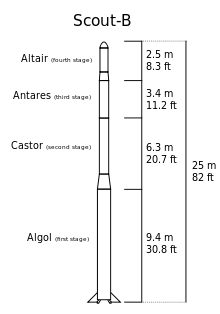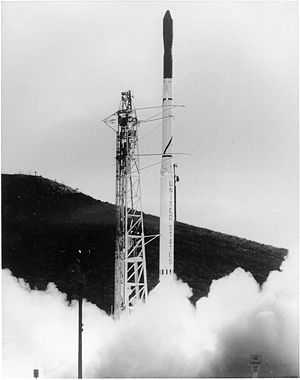Algol (rocket stage)
The Algol family of solid-fuel rocket stages and boosters built by Aerojet (now Aerojet Rocketdyne) and used on a variety of launch vehicles. It was developed by Aerojet from the earlier Jupiter Senior and the Navy Polaris programs.[1] [2] Upgrades to the Algol motor occurred from 1960 till the retirement of the Scout launch vehicle in 1994.
Solid propellant rocket stage. Loaded/empty mass 10,705/1,900 kg. Thrust 470.93 kN. Vacuum specific impulse 236 seconds. Variations included Algol I, I-D, II, II-A, II-B and possibly others. Another popular rating was 40KS-115,000 (52,000 kgf for 40 seconds), also known as Senior.
They were initially developed as the first-stage motor of the Scout rocket. The design was based the Polaris, a sea-to-air missile developed for the United States Navy at the Jet Propulsion Laboratory.[3][4]
Algol 1 (XM-68)
- Algol 1 (XM-68)
- This rocket design started as the Polaris test motor, 31 feet in length with a 40 inch (1.02m) diameter steel case, and 86,000 lb. of thrust.
- The eventual UGM-27 Polaris A-1 was larger, 28.5 feet (8.5m) in length and 54 inch (1.4m) in diameter.
- The Algol 1 was first used for a successful suborbital launch of a Scout X-1 rocket on September 2, 1960.[5] This rocket started as a UGM-27 Polaris test motor with a 40 inch diameter, which at the time was the largest solid motor ever tested. It had a nominal performance rating of 45 seconds duration and 45,000 kgf thrust.
- It was 19.42 feet (5.92 m) long, 2.6 feet (0.79 m) in diameter, and had a burn time of 27 seconds.
Scaled up to 1.02m diameter (40 inches). Later versions for Scout D scaled to 1.14m (45 inches)
- Algol 1-A
- Used on the Scout X (Cub Scout) test flight flown April 18, 1960. served as prototype vehicle for eventual Scout rocket.
- Algol 1-B
- Used on Scout X-1, RM-89 Blue Scout I, and RM-90 Blue Scout II.
- Algol 1-C
- Used on the Scout X-1A. After this single flight, the Scout X-2 with Algol 1-D replaced this prototype.
- Algol 1-D
- Used with Scout X-2, Scout X-2M and Little Joe II. Solid rocket stage. 440.00 kN (98,916 lbf) thrust. Mass 10,700 kg (23,589 lb).
- It was first used on the Scout X-2 on March 29, 1962. It continued to be used on Scout X-2 and Scout X-2M launches (4) until 1963.
_-_cropped.jpg)
- Algol 1-D was first used on the [QTV]] Little Joe II Qualifying Flight in 1963.
• May 13, 1964 – Algol Boosts Little Joe II A-001 flight. An Aerojet-built Algol 1D heavy-duty rocket motor performed successfully for the 36th consecutive time on May 13, 1964 as it carried a NASA Little Joe II spacecraft on the Apollo program A-001 test flight. Averaging 96,650 pounds thrust, the Algol 1D was the largest solid rocket motor flying in non-military space programs. Test hardware on May’s successful Apollo test flight included: an unmanned instrumented command module, service module, launch escape system and the Little Joe II launch system.
Algol engine used on Little Joe II Thrust: 465 kN each Length: 9.1 m Diameter: 1 m Weight full: 10,180 kg Weight empty: 1,900 kg Fuel: solid Burn time: 40 s
Status: Retired 1966. Gross mass: 10,700 kg (23,500 lb). Unfuelled mass: 1,200 kg (2,600 lb). Height: 9.40 m (30.80 ft). Diameter: 1.02 m (3.34 ft). Thrust: 440.00 kN (98,910 lbf). Burn time: 44 s. Number: 20 .
Algol II

- Algol II
- The Algol 2 (Algol II) series was first flown in 1962.
- It was used a first stage on Scout A, Scout B, Scout X-3, Scout X-4;
- It was proposed as a strap-on motor for the Titan 3BAS2 variant (cancelled). It was also proposed for the Athena RTX program in 1969, losing to Thikol.<GAO> B-165488, JAN. 17, 1969
Thrust (sl): 513.300 kN (115,394 lbf). Thrust (sl): 52,347 kgf.
- The 3BAS2 configuration of Titan 3B rocket proposed by Martin in mid-1960's would have used for deep space missions with a Centaur upper stage, Algol strap-on for liftoff thrust augmentation. Never flown.
- CSD solid rocket engine. 564.2 kN. Isp=255s.
Gross mass: 11,600 kg (25,500 lb). Unfuelled mass: 1,650 kg (3,630 lb). Height: 9.09 m (29.82 ft). Diameter: 1.01 m (3.31 ft). Thrust: 564.20 kN (126,837 lbf). Specific impulse: 255 s. Specific impulse sea level: 232 s.
- Algol II-A
- Introduced in 1963 using the Aerojet 40 KS motor.
- First flew on Scout-X3 in 1963.
- Algol II-B
- After an Algol II-A flight failure, the nozzle was designed and designate the II-B model.
- First flew on Scout-X4
- Algol II-C
- Flew on Scout A1 and B1. Scout-A2, -B2, -C and -2 versions planned for Algol II-C were never used.
Algol III
- Algol III
- In 1972, the Algol III was developed by the Chemical Systems Division of United Technologies. The Algol III is a new high-performance solid rocket motor developed for use as the first stage of the NASA SCOUT-D and -E launch vehicles. It was first flown on Scout D-1 in 1972.
- The motor diameter was increased 45 inch (1.14m), providing 104,500 lb trust. This was a 30% improvement of lifting capacity versus the Algol II-B.
- During this two-year program, two development and three qualification motors were successfully static-tested. The motor is 45 in. in diameter, has a length-to-diameter ratio of 8:1, and delivers an average of 100,000 lb of thrust for an action time of 72 sec. The motor design features a very high volumetrically loaded internal-burning-charge design of 17% aluminized composite polybutadiene propellant, a plasma-welded and heat-treated 4130 steel alloy case, and an all-ablative plastic nozzle liner enclosed in a steel shell. The only significant development problem encountered was tailoring the grain design to account for erosive burning effects produced in the high length-to-diameter ratio, high subsonic mach number port. In this paper, the program development results will be presented, together with design descriptions and fabrication methods for each of the major components.
The motor delivers a 30% gain in total impulse over its predecessor and provides a 35-45% gain in payload mass capability at a fractional increase in cost. Algol III has successfully completed development and qualification at United Technology Center under contract to LTV Aerospace Corp.'s Vought Missiles and Space Co., the SCOUT prime contractor for the NASA Langley Research Center.
The Scout X-2 which in 1962 introduced the Antares IIB stage upgrade. On 1962-08-23 a Scout X-2 was used for the first successful launch of a DMSP satellite, lifting off from Point Arguello near Vandenberg Air Force Base.[9][10] The Scout X-3 which in 1963 introduced the Algol IIA upgrade. The Scout A-1 and B-1 which in 1965 introduced the Castor IIA and Altair III upgrades, respectively. The Scout D-1 which in 1972 introduced the Algol III upgrade. The Scout G flew from 1974 until the Scout's retirement in 1994. It was rated to orbit a 210 kg payload.
See also
References
- ↑ Walter Edward Hammond (1999). Space Transportation: A Systems Approach to Analysis and Design. AIAA.
- ↑ "Scout Launch Vehicle Program". NASA.
- ↑ "NASA'S SCOUT LAUNCH VEHICLE". NASA GSFC.
- ↑ "SERGEANT". Redstone Arsenal.
- ↑ "TSE - Scout". The Satellite Encyclopedia.
- ↑ Felix, Bernard R. and McBride, Neil M. (1971). "Development of the Algol III Solid Rocket Motor for Scout" (710765). SAE.
| ||||||||||||||||||||||||||||||||||||||
